thanks for the link, i found it helpful tooIf you want to try a quicker method of finding the the tune for your rifle, give the Purdy PRX a look. Listed on this page.
http://www.rimfirebenchrest.com/tools/test-page.html
You are using an out of date browser. It may not display this or other websites correctly.
You should upgrade or use an alternative browser.
You should upgrade or use an alternative browser.
Rimfire Tuners
- Thread starter BP1
- Start date
BP1
Silver $$ Contributor
So I have the pro x tuner with the brass weights and the other weights..the inner part of the brass weight is fine threaded and the outer threads are coarse threads.So what am I missing here would like to add as much weight needed if need be but can’t with the way the threads are.What do I need for this to work?
Stick it on and get some good rounds to test. I ran the full adjustment range of the tuner and found some great nodes to retest. They have repeated for different rounds.This is awesome to see because I have a Harrel's tuner for my CZ457 but could never figure it out so it just sits on my bench. I tried it several times but just couldn't decipher the results to know what I was going after.
linekin
Silver $$ Contributor
I'm not very familiar with your tuner other than I've heard of them. The brass weight is on the end of your tuner currently? Which end goes on to the Pro-X tuner? Could it be an adapter for the standard Riverside/Harrel's weights?So I have the pro x tuner with the brass weights and the other weights..the inner part of the brass weight is fine threaded and the outer threads are coarse threads.So what am I missing here would like to add as much weight needed if need be but can’t with the way the threads are.What do I need for this to work?
BP1
Silver $$ Contributor
Yeah I figured it out..will have to go with the Harrell weight system..just don’t know why in the hell someone would put coarse on one side and fine on the otherI'm not very familiar with your tuner other than I've heard of them. The brass weight is on the end of your tuner currently? Which end goes on to the Pro-X tuner? Could it be an adapter for the standard Riverside/Harrel's weights?
doclu60
Silver $$ Contributor
BP1,Yeah I figured it out..will have to go with the Harrell weight system..just don’t know why in the hell someone would put coarse on one side and fine on the other
To answer your original question, I am currently using Stiller tuners. They are similar to the Harrell's, but with tighter tolerances and additional locking screws. Several guys I know are now using Stiller tuners and are very happy with them, myself included. I have had an Ezell years ago (sold it), several Harrell's (two still in use), Pro-X (in use), and my second Stiller is coming soon. Future tuner purchases will be Stiller.
I have no idea why the Pro-X has different threads on the optional brass weight. I do know the brass weight is made available to bring the weight of the tuner up to what a Harrell weighs since the Pro-X is lighter than the Harrell. I can only 'guess' that if one wanted to add weight that the MFG thought the first step for the end user would be to go to the Harrell weight first? Don't know for sure.
As you have figured out, Riverside/Harrell's weights fit the fine threaded end of the brass weight. The Pro-X can be ordered with, or without the brass weight. Without the brass weight typical weights can not be used.
There has been hundreds of pages written on forums discussing tuners and tuning. Pretty much everything under the sun has been discussed and the opinions and methods range from one extreme to the other. Since I had a few different tuners and you were asking about what people use, I threw one in no one has mentioned, and several people I know like them very much. Your Pro-X is up to the task with the proper amount of testing. I won't be selling mine, but as mentioned, my future tuner purchases will be Stiller. Good luck with your tuning.
Scott
Last edited:
BP1
Silver $$ Contributor
Scott thank you for your time and explanation on what you have experienced on tuners.BP1,
To answer your original question, I am currently using Stiller tuners. They are similar to the Harrell's, but with tighter tolerances and additional locking screws. Several guys I know are now using Stiller tuners and are very happy with them, myself included. I have had an Ezell years ago (sold it), several Harrell's (two still in use), Pro-X (in use), and my second Stiller is coming soon. Future tuner purchases will be Stiller.
I have no idea why the Pro-X has different threads on the optional brass weight. I do know the brass weight is made available to bring the weight of the tuner up to what a Harrell weighs since the Pro-X is lighter than the Harrell. I can only 'guess' that if one wanted to add weight that the MFG thought the first step for the end user would be to go to the Harrell weight first? Don't know for sure.
As you have figured out, Riverside/Harrell's weights fit the fine threaded end of the brass weight. The Pro-X can be ordered with, or without the brass weight. Without the brass weight typical weights can not be used.
There has been hundreds of pages written on forums discussing tuners and tuning. Pretty much everything under the sun has been discussed and the opinions and methods range from one extreme to the other. Since I had a few different tuners and you were asking about what people use, I threw one in no one has mentioned, and several people I know like them very much. Your Pro-X is up to the task with the proper amount of testing. I won't be selling mine, but as mentioned, my future tuner purchases will be Stiller. Good luck with your tuning.
Scott
Brett, very interesting data.. do you know what the axial displacement is for one revolution of ur tuner? your data clearly shows how wide your accuracy node is..The Harrel tuner has 25 clicks/stops per revolution and a total number of 500 clicks. I selected to shoot every 6 clicks. Three shot groups at each point. The points were shot on a target with 1 inch squares. Each point had a 4 square arrangement to see quadrant hits. The groups were plotted on a graph. I selected to reshoot nodes that were on point of aim. Some nodes can be seen to shoot well with small groups but they were off point of aim. Ammo was Center-X that was rim checked and a single group used. I followed up with some Tenex and the tuner repeated.
Only went one complete turn from zero in both directions indexing one number at a time and fired three shots all on a good day with less than 5mph variable wind at 50 yds. Found a repeatable node for my lot of Midas under .2”. I installed according to Mike Ezell directions. My barrel is short and light at 21” and .750” at the muzzle. #5 Shilen RF. Rimx with MPA chassis and Valdada 36x42 scope. As I am not a competitive shooter, it works a little better than my 1907 Anschutz with 21” barrel in a 54MS wood stock.
The total travel from 0-500 is equivalent to .500 inches. One revolution is .025in. I found some data online that states heavy short barrels vibrate at a faster frequency then longer lighter barrels. Now small changes on a tuner that is on a shorter heavier barrel will change at a faster rate then on longer lighter barrels.Brett, very interesting data.. do you know what the axial displacement is for one revolution of ur tuner? your data clearly shows how wide your accuracy node is..
Thank you Brett..The total travel from 0-500 is equivalent to .500 inches. One revolution is .025in. I found some data online that states heavy short barrels vibrate at a faster frequency then longer lighter barrels. Now small changes on a tuner that is on a shorter heavier barrel will change at a faster rate then on longer lighter barrels.
Last edited:
Hi, only for information.
everyone has his method, most shooters test with trial and error.
Benchrest shooters can use a tuner. In some disciplines no tuner is allowed.
There you have to search for harmony using the speed of the bullet,
or to change the vibration with a weight at the mouth.
At the turning point, the pendulum speed is zero.
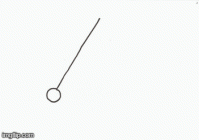
for the bullet this is the best moment to leave the muzzle
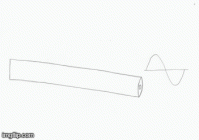
To measure the best moment, I built a measuring device.
(it was not easy, my hair turned gray )
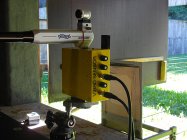
So I can just check the harmony or the right moment.
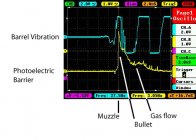
Thanks for the attention.
Greetings.
everyone has his method, most shooters test with trial and error.
Benchrest shooters can use a tuner. In some disciplines no tuner is allowed.
There you have to search for harmony using the speed of the bullet,
or to change the vibration with a weight at the mouth.
At the turning point, the pendulum speed is zero.

for the bullet this is the best moment to leave the muzzle

To measure the best moment, I built a measuring device.
(it was not easy, my hair turned gray )

So I can just check the harmony or the right moment.

Thanks for the attention.
Greetings.
Thank you for doing this! I agree with the principle entirely and I've preached it for years, since doing a couple of rounds of similar vibration analysis testing.Hi, only for information.
everyone has his method, most shooters test with trial and error.
Benchrest shooters can use a tuner. In some disciplines no tuner is allowed.
There you have to search for harmony using the speed of the bullet,
or to change the vibration with a weight at the mouth.
At the turning point, the pendulum speed is zero.
View attachment 1222024
for the bullet this is the best moment to leave the muzzle
View attachment 1222025
To measure the best moment, I built a measuring device.
(it was not easy, my hair turned gray )
View attachment 1222030
So I can just check the harmony or the right moment.
View attachment 1222031
Thanks for the attention.
Greetings.
Trust me, there are those that will argue against what they are seeing with their own eyes because it's counter to what they've read or heard, elsewhere.
Tuning is not some mystical, magical thing..it's physics and it's about timing bullet exit with muzzle position for best accuracy.
If ya really want to trip some up, tell them that there's is no such thing as a "parallel node" and that bullet exit should occur at an anti-node, which is what you are showing.
good job!... do you have more info on your test setup / test results?Hi, only for information.
everyone has his method, most shooters test with trial and error.
Benchrest shooters can use a tuner. In some disciplines no tuner is allowed.
There you have to search for harmony using the speed of the bullet,
or to change the vibration with a weight at the mouth.
At the turning point, the pendulum speed is zero.
View attachment 1222024
for the bullet this is the best moment to leave the muzzle
View attachment 1222025
To measure the best moment, I built a measuring device.
(it was not easy, my hair turned gray )
View attachment 1222030
So I can just check the harmony or the right moment.
View attachment 1222031
Thanks for the attention.
Greetings.
This seems to match LS dyna analysis which shows that if you get the bullet to exit to the "left" of the first barrel harmonic or close to peak (zero velocity), you get better results. Short answer, the muzzle velocity on the "left" is less than the "right" since the barrel is accelerating and velocity is increasing with time ; therefore , reloading variability will simply produce tighter groups.
Last edited:
Hello 1Merlin,Simply Incredible. (Said in awe and deference to your knowledge) If I might ask you... Is the research work you are showing us related to your profession?
Yes a little. Sometimes I give ISSF Shooter support.

And now a little technical info and that's good.
In Germany, the benchrest scene is little.
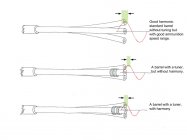
Another example with a standard M54 barrel with slow and fast ammunition.

That's all. Many Greetings.
Similar threads
Upgrades & Donations
This Forum's expenses are primarily paid by member contributions. You can upgrade your Forum membership in seconds. Gold and Silver members get unlimited FREE classifieds for one year. Gold members can upload custom avatars.

Click Upgrade Membership Button ABOVE to get Gold or Silver Status.
You can also donate any amount, large or small, with the button below. Include your Forum Name in the PayPal Notes field.
To DONATE by CHECK, or make a recurring donation, CLICK HERE to learn how.

Click Upgrade Membership Button ABOVE to get Gold or Silver Status.
You can also donate any amount, large or small, with the button below. Include your Forum Name in the PayPal Notes field.
To DONATE by CHECK, or make a recurring donation, CLICK HERE to learn how.









